First bell cast for carillon model
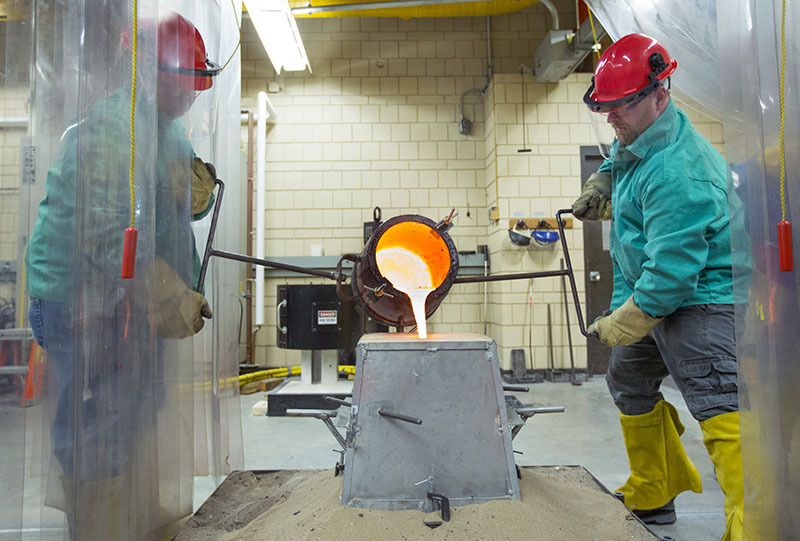
From left, Bill and Joshua Meeks, of the Meeks, Watson and Co. bell foundry, pour a blend of copper and tin into a mold (watch the video). It is the first of 27 bells being cast for a one-fifth scale model of the campanile and carillon. Photos by Christopher Gannon.
A multiyear, student-led project is one bell closer to reality. On Tuesday, one of 27 bells for a one-fifth scale playable model of Iowa State's iconic campanile and carillon was poured in Black Engineering's metalcasting lab.
Representatives from the Ohio-based Meeks, Watson and Co. bell foundry worked with lab technicians to cast the bell. A crowd in the Memorial Union's Campanile Room watched a livestream of the casting as part of an informational program about the project.
Since the spring 2016 semester, the project has provided hands-on learning for student teams in five engineering classes. Design and music students also have been involved. Tin-Shi Tam, Cownie Professor of Music and the university's carillonneur, is the project "client" working with the capstone classes.
Iowa State's Stanton Memorial Carillon has 50 bells, ranging in size from nine to 5,484 pounds. Foundry partner Richard Watson said the bell cast on campus was No. 14 in the set of 27 planned for the scale model. The finished bell will be about 38 pounds, 10 inches in diameter and eight inches tall. He said the largest and smallest bells will weigh about 140 and 15.5 pounds each, and measure about 14 and 5.5 inches tall, respectively.
"The bells of this set are about the same size as the smallest two octaves of the Stanton carillon," Watson said.
Watson said bell No. 14 will be taken to the foundry, where it will be tuned to ring C-sharp in octave six. The rest of the bells will be cast and tuned in Ohio, then delivered to campus in November for installation. This summer and next fall, students will fabricate the model's steel structure and facade in preparation for the bells.
A project website provides information, updates and timeline. Tam plans to use the portable model for outreach events, teaching and performances. Individuals interested in supporting the project can contribute to a fundraising campaign.
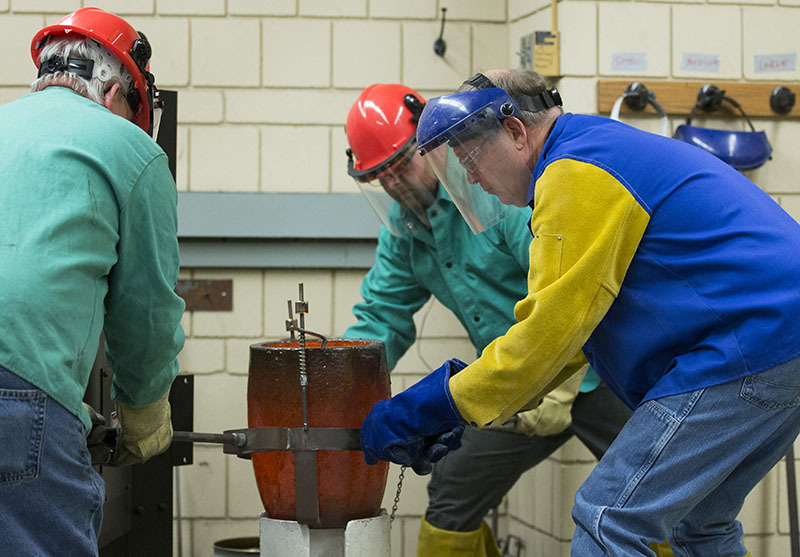
A mixture of copper (79 percent) and tin (21 percent) is heated to more than 1,900 degrees Fahrenheit before being poured into the bell mold. Pictured, workers prepare to move the crucible containing the molten mixture.
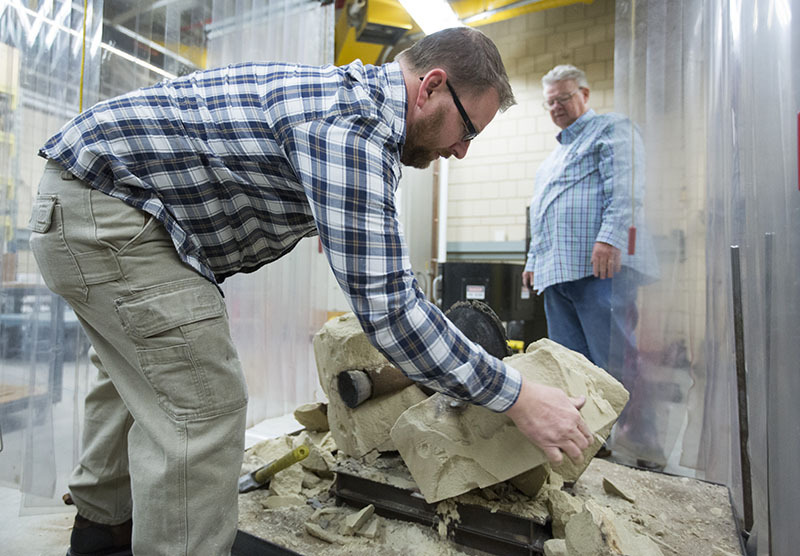
Joshua Meeks (left) works to remove the bell from its compressed sand mold Wednesday morning after 15 hours of cooling. Bill Meeks looks on.
Related story
- Class designs playable carillon model, April 28, 2016
First phase of CyRide changes is coming May 5
After more than a year of public input, study and consultant's assistance, CyRide will implement a first round of changes to the public transit system on Saturday, May 5. A majority of route changes are scheduled for early August, just before the new academic year begins. The changes are part of CyRide 2.0, a comprehensive plan for improving bus travel throughout the community.
One of the biggest changes is a return to 2011 fares, creating savings of 17 to 20 percent on most passes and lowering the cash fare from $1.25 to $1. Transit director Sheri Kyras said the CyRide board of trustees wants to encourage more Ames residents who aren't ISU students to ride the bus. She said 94 percent of CyRide's volume is ISU students, up from 89 percent about a decade ago. Kyras also noted nonstudent ridership has declined steadily since CyRide increased its rates in 2012.
"We don't know what rider behavior is going to be, but we'd like to reverse that trend and increase ridership from the Ames community," she said.
CyRide fares: Rate comparison
|
Fare |
May 5 |
May 5 reduced* |
Current |
Current reduced* |
|
Cash fare (single ride) |
$1 |
$0.50 |
$1.25 |
$0.60 |
|
10-ticket book |
$10 |
$5 |
$12 |
$6 |
|
Pass: calendar month |
$35 |
$17 |
$40 |
$20 |
|
Pass: summer |
$80 |
$40 |
$100 |
$50 |
|
Pass: fall |
$130 |
$65 |
$160 |
$80 |
|
Pass: winter |
$120 |
$60 |
$150 |
$75 |
|
Pass: school year |
$260 |
$130 |
$320 |
$160 |
*Reduced: K-12 students, individuals with disabilities, Medicaid/Medicare cardholders, individuals over 65 years old
ISU-subsidized CyRide passes
Iowa State staff, faculty and postdocs may purchase a pass subsidized by the parking division, equal to about a 30 percent discount, at the ISU Book Store, Memorial Union; CyRide office or City Hall. Individuals must show either an employee ID card or current pay stub to prove eligibility. Those passes also will drop in price on May 5.
|
Pass |
May 5 |
Current |
|
Calendar month |
Not available |
Not available |
|
Summer |
$55 |
$70 |
|
Fall |
$90 |
$115 |
|
Winter |
$85 |
$105 |
|
School year |
$180 |
$230 |
New policy: No courtesy stops
The consultant team hired to assist with CyRide's yearlong study, Nelson-Nygaard, told board members that CyRide is a large transit system still trying to operate with small-town policies. One of those is drivers' willingness to wait -- or even stop for -- a single rider who is late. On May 5, that courtesy will end. To keep buses on schedule and maintain the desired spacing between buses on the same route, drivers no longer will wait for riders running to catch up with a moving bus.
"We realized it's a customer service issue," Kyras said. "Waiting for one rider is really very nice, but you also keep 50-60 other riders waiting, or maybe even late for where they need to be. There has to be some balance."
Shorter intervals between buses is one of the changes coming to CyRide's high-capacity routes in August. So, the wait will be shorter for riders who miss a bus.
Kyras said the goal is efficiency and providing a higher level of service. She also noted that after 6 p.m. and on weekends, when intervals lengthen between buses, drivers will do their best to help riders with transfers.
May route changes
While most route changes will occur later this summer, these CyRide route changes take effect May 5:
- The pink and gray routes, which serviced east and southeast Ames from city hall and central campus, respectively, will end and be replaced with curb-to-curb weekday service. The East Ames Service Extension (EASE) will take riders from City Hall to anywhere in the EASE zone (along East Lincoln Way and Dayton Road from the federal animal research facilities to Southeast 16th Street). Riders call CyRide to arrange return rides to City Hall or anywhere in the east zone.
- The yellow route, which connects downtown to the Southdale neighborhood via South Duff Avenue, will provide all-day service (currently suspended for about five hours mid-day) with increased frequency (30 minutes). Saturday service also will be added.
- The plum route, a weekday-only route that connects campus to the South Duff/South 16th Street area, will now continue to operate during summer and ISU breaks. During the summer, the frequency will change from 20 minutes to 40 minutes.
CyRide has summarized all the route changes in an online document.
How student evaluations are used, from three perspectives
For students, it's difficult to recognize the impact of the end-of-semester evaluations they're asked to provide for courses they've taken and the faculty who taught them. But their ratings and comments are vital to ensuring and improving teaching effectiveness.
The value of student evaluations of teaching -- data which isn't collected or analyzed at a university-wide level -- depends on who is using it and how. To offer insight on helpful ways to consider the data, the Center for Excellence in Learning and Teaching convened a faculty member, a former department chair and an associate dean to talk about their approaches. Here are some highlights from the April 5 panel:
'Teaching really matters'
As of fall 2016, about 6,300 Iowa State courses used the online Class Climate system for student evaluations of teaching, with students filling out more than 130,000 surveys that semester, said Amy Slagell, associate dean for academic programs in the College of Liberal Arts and Sciences. For LAS administrators, that mass of data has three main uses, she said.
The most frequent usage is in promotion and tenure decisions, where evaluation data combines with other measures such as peer observation to show a professor is succeeding in the classroom, Slagell said. Similar information is used in the college's in-depth reviews of tenured faculty every seven years.
Task force seeks input
A Faculty Senate task force is studying ways to make student evaluations of teaching more effective and fair. If you have comments or thoughts on the issue, contact task force chair Jonathan Sturm, jsturm@iastate.edu.
"The teaching really matters here," Slagell said. "It has to be solid to move forward."
However, administrators are aware of research into student evaluation bias and recognize that "not everybody can be above average," she said.
Evaluation comments and data also are useful when students raise concerns about a course or an instructor, helping to determine if the criticism is widely held, Slagell said.
"I know chairs look at it, but sometimes they're looking at a lot of course evaluations at the same time, so something might not have popped out," she said.
The third common use of student feedback is for recognizing excellent teaching. While materials supporting a faculty teaching award include numerous aspects, strong evaluation data is always part of the narrative, Slagell said.
"We want to catch people being good," she said.
Slicing and dicing
Kristen Constant has been interim vice president and chief information officer since Dec. 1, after serving five years as chair of the materials science and engineering department. As chair, she took a highly analytical approach to student evaluations.
Constant plotted course grades versus evaluations to ensure higher marks for students didn't mean higher marks for faculty. She analyzed evaluations based on year in school and course level. She shared anonymous data within the department so faculty could see how they compare. To root out bias, she compared instructors' summary scores -- a single rating meant to gauge overall effectiveness -- to an average of their scores for individual characteristics, ratings on specific aspects of teaching such as feedback quality, organization and clarity.
"I like data, so I slice it and dice it a lot," she said.
For more information
To learn more about creating, administering and analyzing student evaluations of teaching, see CELT's website devoted to assessment and evaluation.
For faculty performance evaluations, students' written comments were crucial, but she also looked at the high and low individual characteristic scores and discussed with faculty ways to address patterns of low performance. Faculty who scored two standard deviations below their colleagues were required to use an early-term evaluation and have peers observe them in the classroom, as was anyone preparing for a third-year or tenure review.
Constant is a big fan of early-term evaluations, which are conducted just a few weeks into a semester. Evaluation at that stage is meant to be formative, helping students take ownership of their learning and giving faculty feedback they can use immediately as the course progresses.
Early-term evaluations also were used by any instructor teaching a course for the first time, no matter their experience. Constant said many MSE faculty use them for every class they teach.
"They're extremely useful. You buy a lot of goodwill when you go back and respond to students' concerns," she said.
Continuous adjustment
When Elena Karpova, professor of apparel, merchandising and design, looks at her student evaluations, she's most interested in what her students are unhappy about. Seeing that she was ranked lower in explanation, for instance, helped her realize she'd incorrectly assumed her students grasped the purpose of her teaching methods.
"I was like, 'Wait, maybe they don't understand why I'm doing things,'" she said.
To be more transparent, she began explaining up front, either in class or on the syllabus, the reasoning behind different course activities. Often, she uses comments from past student evaluations to help make her points.
Like Constant, Karpova sees great value in early-term evaluations. She uses a Plus/Delta assessment early on in every course, a tool that asks students to consider their own efforts and the teaching of the course. Results are shared with the class. Though the feedback is remarkably consistent, it's still useful as another way to explain the "why" behind class assignments and activities, she said.
In addition to the standard voluntary course evaluation she encourages students to fill out, Karpova administers an evaluation of her own design during class time at the end of the semester. She lists each class activity and asks students to select which were most helpful for their learning. She also asks what could be changed to be more helpful, what they'd like to know more about and three takeaways from the course.
"It's very eye-opening for me," said Karpova, who adjusts her course materials based on the feedback.
That's how she knows that while students may not like her before-class online quizzes covering the assigned reading, they end up recognizing it forces them to keep pace.
"Even though they complain, at the end they said it was helpful for their learning," she said.
ISU is working to comply with new EU data privacy law
A campus working group is preparing recommendations for how Iowa State should handle the European Union's new data privacy law, which takes effect next month. Among other requirements, the General Data Protection Regulation (GDPR) requires legal bases to process the personal data of a person in an EU nation.
Under the GDPR, personal data is information that can be used to identify people, including names, photos, email addresses, bank details, social media posts, medical information or computer IP addresses. Processing means any operation performed on personal data, such as collecting, recording, organizing, adapting, altering, disseminating or erasing.
The law undoubtedly will have some effects on Iowa State. The university recruits and enrolls students from EU countries. Students and faculty study, teach and research in the EU. The College of Design's program in Rome has a vast footprint. This activity creates data Iowa State processes, which means it needs a legal basis such as consent, a legal or contractual requirement, or a "legitimate interest," which is balanced against the impact on the individual in order to do so.
Stakeholders across campus are reviewing their systems to identify what data is affected by the GDPR. A legal basis for processing the data will then need to be identified. Iowa State must comply with the law by May 25, when it goes into effect.
The working group will recommend best practices to impacted departments. Recommendations may include treating all data as if it were subject to the EU regulations, purchasing software that identifies and treats personal data in compliance with the GDPR, and performing regular internal audits to ensure compliance.
Questions about the process may be directed to Drew Nishiyama in the university counsel's office at drewnish@iastate.edu or 294-5352.
Student works on growing food in space for NASA
Editor's note: This story was written fall semester as an assignment in Journalism 347, Science Communication. Inside Iowa State periodically publishes student stories that are relevant to our campus audience.
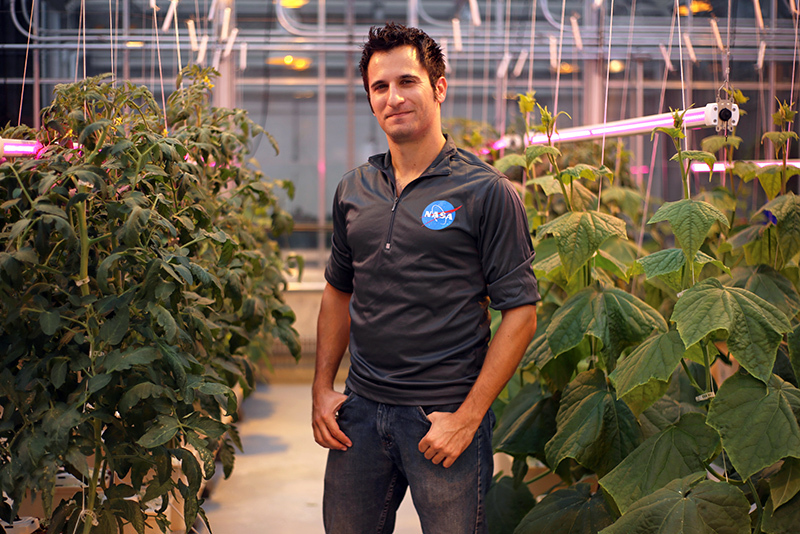
Graduate student Alex Litvin in a Horticulture Hall hydroponics lab, where water, light and fertilizer grow plants such as tomato (left) and cucumber (right). Photo by Jessie Darland.
Using his background in technology and horticulture, doctoral student Alex Litvin interned with NASA last summer to study how to grow plants in space.
Litvin worked for 10 weeks in NASA's Greenwerks lab at Kennedy Space Center, Florida, with a group of scientists who look at ways to grow salad-type plants in space as part of the Vegetable Production System -- or "Veggie."
The Veggie team's efforts are part of a larger NASA project, Deep Space Gateway, which is exploring ways to extend space travel by having a station on the moon astronauts could stop at on longer missions, possibly to other planets.
Litvin said NASA acknowledges there are a few problems that need to be solved before they can begin any sort of planetary travel or space colonization. Finding a way to provide enough food for astronauts is one of them.
"We realize how hard it is to actually go and live in space," Litvin said.
Growing food in space would be more economical for deep space travel than taking all of the food needed for the entire mission.
"Every little bit of weight costs a lot of money," Litvin said. "If you think about space flight, the amount of money you would need to make a rocket for the amount of food you need to survive -- it's not reasonable."
Where technology meets horticulture
Litvin grew up in Silicon Valley area of California, where many students in his high school were gearing up to become programmers and work in tech fields. He was certified as a computer technician, taught the basics of electrical engineering by his father and learned programming. Afraid of a cubicle life, Litvin earned his bachelor's degree in wine and viticulture. He worked in that industry for a few years, got pushed toward the sales side and decided he missed the science. He left California for the University of Georgia to get a master's degree in horticulture. He's working toward a Ph.D. in horticulture at Iowa State, with a focus on automated growing methods, including plants grown under LED lights. He works with assistant professor Christopher Currey.
"When I was younger, I really wanted to get away from technology. And then there's a point you realize, in today's world, everyone needs to know something about technology," Litvin said.
His tech knowledge and interest in horticulture led him to automation; exactly what NASA is looking for with its Veggie and Deep Space Gateway projects. NASA's goal, he said, is to grow a plant from seed to harvest through an automated growth system at a station in space so the plant will be ready to harvest when an astronaut arrives.
"I'm just like anyone else. I'll forget to water my plants so I'll let my plants die," Litvin said. "But, I'm really good at taking an hour or so out of my day, building a circuit, putting sensors into a pot and a faucet spigot and just having it water itself."
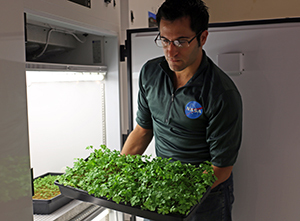
Litvin inspects parsley he's growing in a Horticulture Hall growth chamber. The chamber allows him to control variables -- light, water -- that alter a plant's growth. Photo by Jessie Darland.
Growth options in space
Hydroponics is growing plants without soil, which could be good for space travel and may be an answer for growing in a microgravity environment like that found in space.
"It's a very low commitment for materials because you're not chugging along soil into your system," Litvin said. "You just have tubs that you can immediately grow the plants in with the water they need. Water is continuously recycled in space. Taking a seed is not as much work."
Litvin specializes in controlled environment agriculture (CEA), an area where his work and NASA's overlaps. With CEA, sensor feedback allows horticulturalists to observe and control specific aspects of plant growth such as humidity and light. This data allows them to speed up or slow down the rate of growth by changing a plant's watering plan. Controlling every aspect of the process allows NASA scientists to compare how plants grow differently in microgravity under varying amounts of light and humidity.
This kind of controlled agriculture could be beneficial for growing plants on Earth, too. A controlled environment allows a scientist to observe how a plant will react under certain conditions such as climate change or drought, and then try to find a better way to grow the plant in predicted conditions.
Water presents a challenge
Litvin said the biggest challenge with growing plants in space is how to water them. In space, water adheres to whatever surface it is near, and coheres to other water molecules. When water adheres to a plant, it prevents the plant from getting enough air, basically suffocating it.
NASA is exploring a few hydroponic tactics to solve this problem, for example, 3-D printed substrates. The plants grow in these substrates, designed so the roots can burrow and plants have something to latch onto. Scientists can monitor the amount of water being fed into the substrates.
NASA also is looking at a material called hydrogel. Similar to a baby diaper, it absorbs liquid and then releases it back to the plant when needed
NASA has tried aeroponics -- growing a plant without any soil or container. The plants are suspended so the roots dangle and are sprayed with the water and nutrients the plant needs. However, water adhesion can coat the root and suffocate it. The solution is to use sensors to monitor and try to control the amount of water in the air.
More work to be done
When he's done at ISU, Litvin said he hopes to return to NASA. His goal is to continue working with automation and explore how efficient agricultural approaches can contribute to society.

About the writer: Jessie Darland is a senior from Cedar Rapids. She'll graduate in December with degrees in journalism and international studies and a minor in political science. She's currently in Portland for a 15-week internship at the twice-weekly Portland Tribune. At Iowa State, she worked on the staffs of the Iowa State Daily, Ethos and Veritas. Her post-December goal is to return to the West to work as an environmental writer and photojournalist.
Weeklong events celebrate fashion
Clothing drive
Donate professional attire for the Dress for Success organization through April 18 at three locations:
- 0031 MacKay Hall
- 1071A LeBaron Hall
- E104 Lagomarcino Hall
A week of activity is underway, leading up to The Fashion Show, which hits the runway at Stephens Auditorium on Saturday, April 14 (7 p.m.). The student-led production, now in its 36th year, is based in the apparel, events and hospitality management department.
Clothing items designed by students from any major will be featured on the runway and in exhibits at the show, this year with a "Resilience" theme. A panel of judges evaluated and selected more than 125 items for the juried competition. Scholarships are awarded in multiple categories and to the Best in Show winner.
Tickets to The Fashion Show are $15 to $30, available at the Stephens ticket office or through Ticketmaster. Seating remains available (primarily in the balconies), but expected to be limited by showtime. The show also will be livestreamed.
Some of the winning garments will be on display April 25-July 27 in the Textiles and Clothing Museum's Mary Alice Gallery, open weekdays from 11 a.m. to 4 p.m. Admission is free.
Fashion Week
Events are free unless indicated.
Thursday, April 12
- 10 a.m.-4 p.m., Patagonia Worn Wear Tour, bring clean damaged clothing for repair (Memorial Union west driveway)
- 11 a.m.-3 p.m., Takeover Tuesday, info booth with live music, raffle and T-shirt sales (central campus, or LeBaron Hall lobby if rain)
Friday, April 13
- 10 a.m.-4 p.m., Pop-up shop, info booth with clothing swap, food and T-shirt sales (Parks Library lawn)
- 7-9 p.m., Fashion Week Night Out, live music and reception with guest designers from Patagonia (Garden Room, Gateway Hotel)
Saturday, April 14
- 7 p.m., The Fashion Show, student-designed garments, with guest designers from the Patagonia Company (Stephens Auditorium), $15-$30
